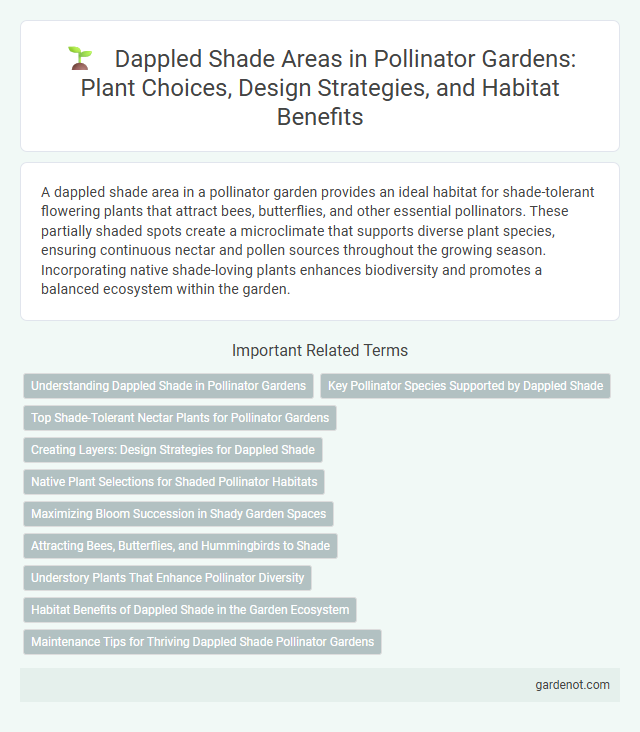A dappled shade area in a pollinator garden provides an ideal habitat for shade-tolerant flowering plants that attract bees, butterflies, and other essential pollinators. These partially shaded spots create a microclimate that supports diverse plant species, ensuring continuous nectar and pollen sources throughout the growing season. Incorporating native shade-loving plants enhances biodiversity and promotes a balanced ecosystem within the garden.
Understanding Dappled Shade in Pollinator Gardens
Dappled shade in pollinator gardens occurs when sunlight filters through tree leaves, creating a mix of light and shadow that supports diverse plant growth. This environment benefits pollinators by providing shelter from extreme heat while offering access to flowering plants adapted to partial sunlight. Selecting native plants like wild columbine and goldenrod enhances habitat quality, attracting bees, butterflies, and other essential pollinators.
Key Pollinator Species Supported by Dappled Shade
Dappled shade areas in pollinator gardens provide an ideal environment for key pollinator species such as bumblebees, hoverflies, and certain butterfly species like the Eastern Tiger Swallowtail. These zones support nesting sites and diverse floral resources that bloom in filtered light, promoting nectar and pollen availability throughout the growing season. Incorporating plants like columbine, wild ginger, and bleeding heart enhances habitat suitability for shade-adapted pollinators in these microclimates.
Top Shade-Tolerant Nectar Plants for Pollinator Gardens
Dappled shade areas in pollinator gardens are ideal for shade-tolerant nectar plants such as Trillium, Solomon's Seal, and Foamflower, which thrive under partial sunlight. These plants provide essential nectar sources for bees, butterflies, and hummingbirds while adapting to the filtered light environment. Incorporating native species like Columbine and Foamflower enhances biodiversity and supports local pollinator populations effectively.
Creating Layers: Design Strategies for Dappled Shade
Designing pollinator gardens in dappled shade requires strategic layering of plants to optimize light availability and habitat complexity. Incorporate a combination of shade-tolerant perennials, such as hostas and foamflowers, with mid-height shrubs like azaleas to create vertical diversity that supports diverse pollinator species. Utilize ground covers like wild ginger to maintain soil moisture and provide continuous bloom cycles, enhancing nectar and pollen resources throughout the growing season.
Native Plant Selections for Shaded Pollinator Habitats
Native plant selections for dappled shade areas in pollinator gardens include species such as Trillium grandiflorum, Solomon's seal (Polygonatum biflorum), and Foamflower (Tiarella cordifolia). These plants thrive under filtered sunlight, providing essential nectar and pollen sources for native bees, butterflies, and moths. Incorporating a diversity of shade-adapted native flora supports pollinator diversity and sustains ecosystem health in shaded garden habitats.
Maximizing Bloom Succession in Shady Garden Spaces
Plant shade-tolerant perennials such as hellebores, astilbes, and lungwort to maximize bloom succession in dappled shade pollinator gardens. Incorporate early spring bulbs like snowdrops and bluebells to extend nectar availability for early-emerging pollinators. Maintain diverse bloom periods by layering understory shrubs such as witch hazel and hydrangeas to support pollinators throughout the growing season.
Attracting Bees, Butterflies, and Hummingbirds to Shade
Dappled shade areas create an ideal habitat for pollinators by providing partial sunlight conditions favored by many shade-tolerant flowering plants. Plants such as columbine, bleeding heart, and coral bells thrive in these environments, attracting bees, butterflies, and hummingbirds with their nectar-rich blooms. Incorporating native flowering species that bloom sequentially ensures a continuous food source, supporting pollinator activity throughout the growing season.
Understory Plants That Enhance Pollinator Diversity
Understory plants in dappled shade areas, such as Solomon's seal (Polygonatum spp.), ferns, and Virginia bluebells (Mertensia virginica), play a crucial role in supporting diverse pollinator populations by providing essential nectar and habitat. These shade-tolerant species extend bloom periods and attract early-season pollinators like bumblebees and butterflies. Incorporating native understory plants in pollinator gardens enhances biodiversity and creates a balanced ecosystem for native bees and other beneficial insects.
Habitat Benefits of Dappled Shade in the Garden Ecosystem
Dappled shade in a pollinator garden creates a microhabitat that supports diverse insect species by offering moderate sunlight and cooler temperatures, essential for pollinators such as bees and butterflies. This environment helps retain soil moisture, promoting healthy plant growth and increasing the availability of nectar and pollen. The interplay of light and shadow in these areas fosters a balanced ecosystem, enhancing biodiversity and encouraging natural pest control.
Maintenance Tips for Thriving Dappled Shade Pollinator Gardens
Regularly removing fallen leaves prevents mold and promotes healthy soil in dappled shade pollinator gardens. Choosing native plants adapted to partial shade reduces water and nutrient requirements while supporting local pollinators. Monitoring soil moisture and avoiding overwatering ensures optimal conditions for flower growth and pollinator activity.
Dappled shade area Infographic

 gardenot.com
gardenot.com